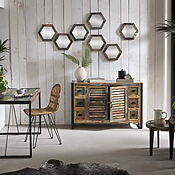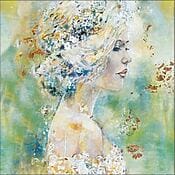Who would have thought that tapestries would experience one of the most exciting comebacks in home decor? These textile works of art have an illustrious history dating back to the 15th century. But they offer far more than just historical splendor. They are impressive works of art and useful furnishings in one. In their renaissance in the 2020s, they are once again lending a special presence to more and more dining rooms, living rooms, entryways, business lofts, and hotel lobbies.
The Aubusson tapestry from the upper Creuse Valley in central France is one of the most recognizable styles and has existed since the 16th century. Modern tapestries, Gobelins, and woven artworks are experiencing a remarkable renaissance in contemporary interior design concepts. They have been important as a means of artistic expression for centuries—usually laboriously handwoven by people, predominantly women, who often had no access to other creative forms of expression.
In addition to their attractive appearance, tapestries have practical benefits that are still evident today: They warm rooms in cold winter months, which was also their original purpose, and they are an important factor in reducing noise indoors. Wool rugs are known for their natural sound-absorbing properties.
Together we explore the world of classic tapestries and modern acoustic paintings – from their eventful history to practical advice on how to stylishly integrate them into contemporary living concepts.
The Gobelins: A Rediscovery
Tapestries originated in 1443, when the scarlet dyer Jean Gobelin settled in the Saint-Marcel district of Paris. An art form that emerged from this humble beginning is now finding its way back into modern homes.
What is special about tapestries?
They were considered masterpieces that required not only patience but also exceptional precision. The dense stitches and meticulous elaboration of every detail create impressive depth and dimension. Tapestries originally served far more than just decorative purposes: They divided expansive halls into smaller spaces and offered practical benefits as thermal and sound insulation.
Tapestries are made from durable materials such as wool, cotton, and even gold thread, giving them remarkable longevity. This durability is the reason why historic examples have survived to this day and continue to delight us with their intricate patterns.
From royal walls to modern apartments
The remarkable breakthrough came in 1601, when Henry IV had the carpet workshops expanded with the help of two Flemish weavers. Later, in 1662, Finance Minister Colbert purchased the workshops and created the famous royal manufactory, which would make France independent of expensive imports from Flanders. What was once reserved only for kings and nobles now finds its place in a wide variety of home designs.
Modern tapestries are versatile: as art objects, furniture covers, curtains, and home accessories. Especially as accents in contemporary interiors, they create an exciting contrast between tradition and modernity.
Tapestry painting and embroidery in comparison
Genuine tapestries differ fundamentally from their imitations. Strictly speaking, they are not woven , but rather knitted . The crucial difference lies in the pattern of the weft threads: they are not continuous, but are used only in specific color areas.
Tapestry embroidery , on the other hand, attempts to imitate the original with small diagonal stitches. Another variation is tapestry painting , which is created by applying paint to a tapestry-like woven fabric—a technique considered by purists to be a "faking" of a genuine tapestry.
Modern tapestry fabrics are often created using jacquard weaving , which looks similar but is significantly less complex to produce, making them affordable.

Tapestries as a modern art form
Far from dusty museum display cases, textile artworks have evolved into a medium of modern expression, combining traditional craftsmanship with contemporary aesthetics. This remarkable renaissance in the contemporary art world demonstrates that tapestries have long since become more than historical relics.
Woven tapestries as art objects
Modern tapestries transcend the boundaries between decorative art and art object. To this day, unique textile masterpieces are created in factories that combine artistic ingenuity with virtuosic craftsmanship. The production of a large-scale tapestry based on an artist's original still requires hundreds to thousands of hours of labor. The ancient techniques of yarn production, dyeing, weaving, and knotting are applied virtually unchanged.
The computer-controlled Jacquard loom offers endless design possibilities today. This technology, named after Joseph-Marie Jacquard (1752–1834), is considered the cornerstone of automation through its introduction of the binary system into mechanical engineering. The first punched cards were actually developed for the implementation of patterns.
Artistic Tapestries in the 21st Century
Numerous renowned artists have tapestry and continually reinterpret tapestry weaving Margret Eicher , Miriam Bäckström , and Laure Prouvost, for example, produce their work in Belgium.
Impressive examples of modern tapestry art are Susan Morris ’ diary-like work “SunDial: NightWatch_Sleep / Wake” , which visualises phases of sleep and wakefulness, Margret Eicher’s “Media Tapestries” , which combine traditional image concepts with digital imagery, and Alexandra Kehayoglou’s hyperrealistic carpets depicting threatened landscapes of Argentina.
Young artists like Marie Hazard , Tom Atton , and Erin M. Riley are giving textile art a fresh, exciting makeover. Their works address feminism, body image, and contemporary social issues.
Acoustic images: When design meets function

Acoustic pictures are a particularly creative variation of modern tapestries. They significantly contribute to improving room acoustics and reducing reverberation and noise levels. Using these sound-absorbing materials makes conversations clearer and reduces noise.
Modern acoustic panels are an excellent solution for offices, meeting rooms, or medical practices, as they combine high sound absorption with an attractive design. They are both functional and aesthetically pleasing, using environmentally friendly materials with Oeko-TEX® 100 certification and offering customization options. These stylish acoustic elements prevent sound reflections, creating sonic clarity in spaces previously affected by noise.
Practical advantages of tapestries
Beyond their aesthetic qualities, tapestries offer a variety of practical benefits for contemporary living spaces.
Thermal and sound insulation
Tapestries act as natural sound absorbers, reducing noise levels and thus significantly improving room acoustics. Deep-pile carpets are particularly effective, as their long, densely arranged fibers provide a significant surface area for sound absorption. Their specific textile structure absorbs sound waves and transforms them into thermal energy.
Furthermore, tapestries contribute to improving thermal insulation in a room. A wall covered with a carpet has the advantage of retaining heat better, which is particularly useful in rooms with exterior walls. This measure makes it possible to reduce energy costs.
Hiding walls that are not aesthetically pleasing
Another advantage of tapestries is that they can be used to conceal unsightly areas on walls. They can easily conceal stains, minor imperfections, and worn areas. This special characteristic lends them a special significance in historic homes or during temporary living arrangements.
Flexibility in rental apartments
In rental properties with walls that transmit sound well, wall hangings offer an aesthetically pleasing way to improve acoustics. Because they can be installed without the need for drilling, they're particularly well-suited for tenants who aren't permitted to make long-term modifications.
Sustainability through natural materials
Carpets made from natural fibers like wool are environmentally friendly. Wool has natural properties that help absorb sound, is also extremely durable, and requires little maintenance.
Environmentally friendly alternatives are sisal and jute , as they are both made from renewable resources, are biodegradable and have minimal impact on the environment.
A selection of tapestries, tapestries and textile acoustic pictures from our shop

Hand-woven tapestry "samburu man" by Mario Gerth, sound-absorbing
The original price was: € 544.00544,00 €Current price is: € 544.00.
435,20 €
Add to Cart

Togelin wall carpet "Tibetan boy", photo-realistic art print, sound-absorbing
The original price was: € 538.00538,00 €Current price is: € 538.00.
430,40 €
Add to Cart

Handmade Tobelin wall carpet "Klimt's flower garden", sound-absorbing
The original price was: € 542.00542,00 €Current price is: € 542.00.
433,60 €
Add to Cart

Woven wall carpet "Mystic Woman", stretched on a stretcher frame
The original price was: € 598.00598,00 €Current price is: € 598.00.
478,40 €
Add to Cart

Original price was: €2,233.001.950,00 €Current price is: 1,950.00 €.
Add to Cart

Original price was: €2,233.001.950,00 €Current price is: 1,950.00 €.
Add to Cart

Tobelin wall carpet "Adele Klimt" 120/180, photo-realistic print quality, sound absorbing
The original price was: € 964.00964,00 €Current price is: € 964.00.
771,20 €
Add to Cart

Original price was: €2,233.001.950,00 €Current price is: 1,950.00 €.
Add to Cart

Limited acoustic picture “Fur” (140x190cm) – woven textile art on stretcher frame, sound-absorbing
Original price was: €2,233.001.950,00 €Current price is: 1,950.00 €.
Add to Cart

Original price was: €2,233.001.950,00 €Current price is: 1,950.00 €.
Add to Cart

Hand-woven tapestry "Ovakakaona-Stamm Angola" by Mario Gerth, sound absorbing
The original price was: € 544.00544,00 €Current price is: € 544.00.
435,20 €
Add to Cart

Original price was: €2,233.001.950,00 €Current price is: 1,950.00 €.
Add to Cart
Integrate tapestries stylishly into living spaces
The successful integration of tapestries can transform any room into a unique oasis of coziness. We'll share a few essential basics to help you decorate your home with tapestries and textile wall art in no time.
Hanging tapestries: techniques and tips
The weight of the tapestry plays a crucial role in determining the appropriate method for attaching it to the wall. For smaller to medium-sized items, hook-and-loop fasteners are an excellent choice, as they won't damage the wall. For heavier items, nail strips are advantageous, as they provide additional stability and help distribute the weight evenly.
Our advice is to place the rug at a distance of approximately 5 to 10 centimeters from the wall on all sides to ensure it doesn't appear too massive.
Choice of colors and patterns to suit the room
Simple patterns and subtle color nuances are particularly suitable if the tapestry is intended to function as a painting without conveying excessive weight. A rug in a single color can be effortlessly integrated into any existing room design, especially if it remains understated and doesn't distract attention from the other furnishings.
For interior design styles that minimalism , environmentally friendly rugs made from natural materials such as sisal, seagrass, or jute are a recommended choice.
Mix of modern and traditional
The combination of traditional and contemporary elements creates fascinating contrasts and thus generates an interesting dynamic. A traditional rug on the wall in a contemporary room with smooth surfaces can create an atmosphere of sensuality and color.
Deep-pile wall hangings in vibrant colors are an excellent way to create striking and impressive highlights in modern interiors.
Oriental carpets as wall art
An extraordinarily sophisticated and original idea is to use the oriental rug as an artistic wall decoration instead of laying it out on the floor as usual. Mounting it on the wall not only protects it from wear and tear but also creates a striking visual accent, adding dimension and a cozy atmosphere to a contemporary space.
Especially in rooms characterized by light wall colors or Mediterranean or oriental interior design, installing an oriental rug can profoundly change the atmosphere. It lends the room a unique, distinctive touch.

Owner and Managing Director of Kunstplaza. Publicist, editor, and passionate blogger in the field of art, design, and creativity since 2011. Successful completion of a degree in web design as part of a university program (2008). Further development of creativity techniques through courses in free drawing, expressive painting, and theater/acting. Profound knowledge of the art market through many years of journalistic research and numerous collaborations with actors/institutions from art and culture.
































